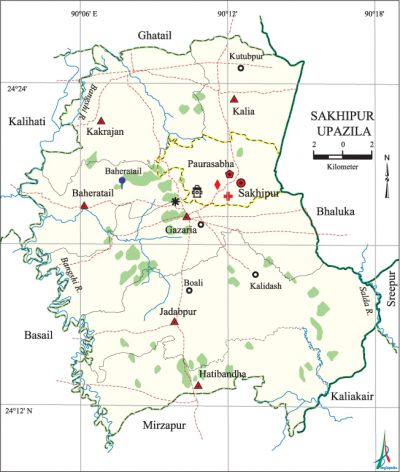Sakhipur Upazila
Sakhipur Upazila (tangail district) area 435.19 sq km, located in between 24°11' and 24°26' north latitudes and in between 90°04' and 90°18' east longitudes. It is bounded by ghatail upazila on the north, mirzapur upazila on the south, bhaluka, sreepur (gazipur) and kaliakair upazilas on the east, kalihati and basail' upazilas on the west.
Population Total 277685; male 132061, female 145624; Muslim 261398, Hindu 15598, Buddhist 9, Christian 59 and others 621.
Water bodies Main rivers: bangshi, Salda.
Administration Sakhipur Thana was formed in 1976 and it was turned into an upazila in 1983.
| Upazila | ||||||||
| Municipality | Union | Mouza | Village | Population | Density (per sq km) | Literacy rate (%) | ||
| Urban | Rural | Urban | Rural | |||||
| 1 | 6 | 60 | 122 | 45645 | 232040 | 638 | 46.6 (2001) | 38.8 |
| Municipality | ||||||||
| Area (sq km) |
Ward | Mahalla | Population | Density (per sq km) |
Literacy rate (%) | |||
| - | 9 | 18 | 30028 | - | 57.6 | |||
| Upazila Town | ||||||||
|
Area (sq km) |
Mouza |
Population |
Density (per sq km) |
Literacy rate (%) | ||||
| 19.68 (2001) | 3 | 15617 | 449 (2001) | 42.2 | ||||
| Union | ||||
| Name of union and GO code | Area (acre) | Population | Literacy rate (%) | |
| Male | Female | |||
| Kakrajan 67 | 16509 | 17997 | 20456 | 36.0 |
| Kalia 81 | 17173 | 25288 | 27846 | 37.9 |
| Gazaria 27 | 6260 | 17987 | 20133 | 40.8 |
| Baheratail 13 | 10656 | 11309 | 13104 | 36.1 |
| Jadabpur 54 | 11407 | 28212 | 30880 | 40.4 |
| Hatibandha 40 | 15039 | 16372 | 18073 | 42.0 |
Source Bangladesh Population Census 2001 and 2011, Bangladesh Bureau of Statistics.

Archaeological heritage and relics Mazar of Shah Kamal (R), an associate of Hazrat Shah Jalal (R) at village Garh GoVindapur.
War of Liberation On 10 June 1971 the Kaderia Bahini took oath at Baheratail of this upazila. A month before the event, in May, freedom fighters had an encounter with Pak army at Bailanpur and there was another encounter at Kachua area of the upazila. An encounter was held on 6 October between the freedom fighters and the Pak army at Balla in which four freedom fighters were killed. There is a martyrs’ memorial in the upazila and a monument has been established at Baheratail, the place where Kaderia Bahini took the oath.
For details: see সখীপুর উপজেলা, বাংলাদেশ মুক্তিযুদ্ধ জ্ঞানকোষ (Encyclopedia of Bangladesh War of Liberation), বাংলাদেশ এশিয়াটিক সোসাইটি, ঢাকা ২০২০, খণ্ড ১০।
Religious institutions Mosque 457, temple 13, tomb 2. Noted religious institutions: Sakhipur Central Jami Mosque, Kutubpur Mosque, Shah Kamal (R) Tomb.
Literacy rate and educational institutions Average literacy 41.1%; male 44.4%, female 38.1%. Educational institutions: college 7, secondary school 60, primary school 136, madrasa 27. Noted educational institutions: Mujib Degree College (1972), Sakhipur Residential Mohila College (1995), Hatiya College (1969), Boali College (1993), Sabuj Bangla High School (1993), Hatiya Haji Hafiz Uddin High School (1964).
Main sources of income Agriculture 69.82%, non-agricultural labourer 1.94%, industry 0.45%, commerce 9.38%, transport and communication 2.22%, service 4.84%, construction 0.67%, religious service 0.14%, rent and remittance 3.67% and others 6.87%.
Ownership of agricultural land Landowner 72.52%, landless 27.48%; agricultural landowner: urban 68.72% and rural 72.99%.
Main crops Paddy, jute, cotton, mustard, potato, wheat, pulse, vegetables.
Extinct or nearly extinct crops Sesame, kalai, arahar.
Main fruits Mango, jackfruit, banana, blackberry, litchi, papaya, pineapple, watermelon.
Fisheries, dairies and poultries Fishery 56, dairy 12, poultry 28.
Communication facilities Pucca road 138.98 km, mud road 540.79 km.
Extinct or nearly extinct traditional transport Palanquin, horse carriage, bullock cart.
Noted manufactories Rice mill, flour mill, saw mill, chira (threshed rice) mill, ice factory, welding factory.
Cottage industries Goldsmith, blacksmith, weaving, wood work, bamboo work, cane work, tailoring.
Hats, bazars and fairs Hats and bazars are 38, fairs 3, most noted of which are Kachua Hat, Barachoana Hat, Nalua Hat, Ratanpur Hat, Hatiya Hat, Sakhipur Bazar, Kutubpur Bazar, Mahanandpur Bazar, Falu Shah Mela and Muslim Dargah Mela.
Main exports Paddy, banana, jackfruit, vegetables.
Access to electricity All the wards and unions of the upazila are under rural electrification net-work. However 72.5% of the dwelling households have access to electricity.
Sources of drinking water Tube-well 89.0%, tap 2.0% and others 9.0%.
Sanitation 67.6% of dwelling households of the upazila use sanitary latrines and 18.7% of dwelling households use non-sanitary latrines; 13.7% of households do not have latrine facilities.
Health centres Hospital 1, veterinary hospital 4, eye hospital 1, satellite clinic 4, family planning centre 10, child hospital 1, brac health centre 1, rural health centre 1, clinic 2, diagnostic centre 1.
NGO activities Operationally important NGOs are brac, proshika. [Harun Rashid]
References Bangladesh Population Census 2001 and 2011, Bangladesh Bureau of Statistics; Cultural survey report of Sakhipur Upazila 2007.
